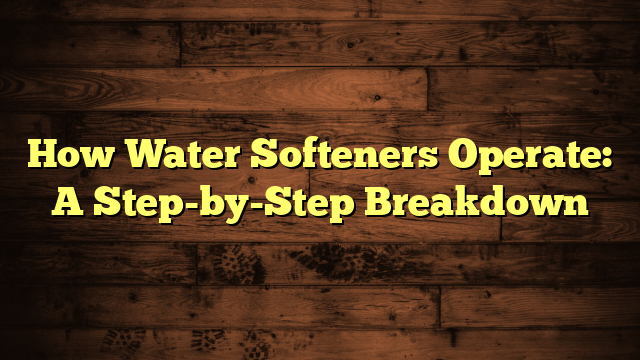Troubleshooting Common Issues With CPMCORD Water Softeners
You'd think your CPMCORD water softener could solve every hard water problem under the sun, but sometimes it just doesn't cooperate. If you've noticed unusual noises, low water pressure, or even salt bridge issues, you're not alone. It's vital to pinpoint these common hiccups to get your system back on track. So, what steps can you take to troubleshoot effectively and guarantee peak performance? Let's explore the essential checks and fixes that can make a significant difference.
Key Takeaways
- Check for unusual noises like humming or gurgling, which may indicate motor issues or trapped air in the system.
- Monitor the regeneration cycle and adjust settings if excessive salt usage is detected, ensuring alignment with manufacturer guidelines.
- Inspect for clogged filters, resin, or pipes if experiencing low water pressure, and clean or replace as necessary.
- Conduct regular maintenance, including cleaning components and inspecting the control panel for error codes or power supply issues.
- Address leaks promptly by tightening connections, inspecting seals, and clearing any clogged drain lines to ensure proper drainage.
Hard Water Stains
Hard water stains can be a frustrating issue in your home. You might notice unsightly marks on your faucets, shower doors, or countertops, and they can be tough to remove. These stains occur when hard water, which contains high levels of minerals like calcium and magnesium, leaves deposits behind as it evaporates. Thankfully, stain removal is possible with the right approach.
To tackle hard water stains, start by mixing equal parts of white vinegar and water in a spray bottle. Spray the affected areas and let it sit for about 10-15 minutes. The acidity in vinegar helps dissolve the mineral buildup.
Afterward, scrub gently with a sponge or cloth, focusing on stubborn spots. Rinse with clean water and dry the surface to prevent future stains.
For tougher stains, consider using a commercial hard water stain remover, following the manufacturer's instructions closely. Always test any product on a small, inconspicuous area first.
Regular maintenance, like wiping down surfaces after use, can help prevent hard water stains from forming in the first place, keeping your home looking clean and fresh.
Unusual Noises
Unusual noises from your water softener can be concerning and often indicate an underlying issue. It's important to identify the noise sources to address the problem effectively. Here's a quick guide to help you troubleshoot:
| Noise Type | Possible Cause |
|---|---|
| Humming | Motor running improperly |
| Gurgling | Air in the system |
| Banging | Water hammer effect |
| Clicking | Valve issues or debris |
When you hear any of these sounds, don't panic. Start with basic troubleshooting steps. Check the installation of your unit to verify everything is tight and secure. Next, listen closely to pinpoint the noise source. If it's a gurgling sound, try bleeding the air from the system. For a humming noise, inspect the motor for signs of wear or misalignment.
If the noise persists after these steps, you might need to consult your user manual or reach out to a professional. Addressing unusual noises promptly can prevent more significant issues down the line and keep your water softener running smoothly.
Regeneration Cycle Issues
If you're facing issues with your water softener's regeneration cycle, it could stem from several factors, including regeneration frequency settings, salt usage problems, or control valve malfunctions.
Understanding how each of these components works is essential for maintaining peak performance.
Let's break down these potential issues to help you get your system back on track.
Regeneration Frequency Settings
When dealing with regeneration frequency settings on your CPMCORD water softener, it's crucial to find the right balance for best performance. Properly adjusting your regeneration settings can greatly impact the efficiency of your system and the quality of your water.
If you notice that your water feels hard or has a strange taste, it might be time for frequency adjustments.
Here are some key points to take into account:
- Usage Patterns: Identify your household's water usage to set appropriate regeneration cycles.
- Water Hardness: Test your water hardness levels; more hardness often requires more frequent regeneration.
- Regeneration Time: Schedule regenerations during off-peak hours, so it doesn't disrupt your daily activities.
- System Settings: Verify your softener is set according to the manufacturer's guidelines for peak performance.
- Monitoring Results: Regularly check the effectiveness of your softener, adjusting settings as needed based on performance.
Salt Usage Problems
Your CPMCORD water softener's salt usage can indicate underlying issues with the regeneration cycle. If you notice excessive salt consumption, it might suggest that your system isn't regenerating effectively.
First, check the type of salt you're using. Not all salt types are created equal; using high-purity salt can greatly improve performance. If you're using rock salt or solar salt, consider switching to evaporated salt for best results.
Next, assess your salt storage. Verify the salt tank is filled correctly and free from clumps. Caked salt can restrict water flow, hindering the regeneration process. If your storage is low, your softener might be running on insufficient salt, leading to inadequate softening.
Regularly inspect the brine tank for any signs of salt bridging, a phenomenon where a solid mass forms, preventing proper salt dissolution. This issue can also drain your salt supply faster than expected.
To maintain efficiency, schedule periodic checks on both your salt type and storage conditions. By addressing these salt usage problems early, you can guarantee your CPMCORD water softener operates at peak performance, keeping your water soft and comfortable.
Control Valve Malfunctions
Salt usage problems can often point to control valve malfunctions, particularly during the regeneration cycle. When the control valve isn't functioning correctly, it can disrupt the entire softening process, leading to inefficient salt usage and reduced water quality. Understanding the different control valve types and maintaining them can help you avoid these issues.
Here are some common signs of control valve malfunctions:
- Inconsistent water softness despite proper salt levels
- Frequent need for salt replenishment
- Unusual noises during the regeneration cycle
- Water bypassing the softener
- Error messages on the control panel
To troubleshoot these problems, start with regular valve maintenance. Check for clogs, verify proper alignment, and clean the valve as needed.
If the issue persists, it may be time to consult a professional. Don't forget to keep an eye on the settings and calibration of your control valve, as incorrect adjustments can also lead to malfunctions.
Low Water Pressure
If you're experiencing low water pressure, it could be caused by various factors related to your water softener.
Common culprits include clogged filters or resin, and even issues with the plumbing itself.
Let's explore the reasons behind this problem and discuss effective solutions to help improve your water flow.
Causes of Low Pressure
Low water pressure can stem from several factors within your CPMCORD water softener system. Understanding the causes of pressure issues is crucial for effective troubleshooting.
Here are some common culprits you might encounter:
- Clogged Filters: Dirt and sediment can pile up, restricting water flow.
- Malfunctioning Valves: If the inlet or outlet valves aren't functioning properly, they can hinder water movement.
- Water Supply Issues: Sometimes, the problem lies outside your system, like municipal supply drop in pressure.
- Improper Installation: If your system isn't installed correctly, it can lead to low pressure.
- Excessive Demand: Running multiple fixtures simultaneously might exceed the available pressure.
Solutions to Improve Flow
Improving flow in your CPMCORD water softener system can often be achieved with a few straightforward adjustments.
First, check your flow rate settings; if they're too low, you might experience diminished water pressure. Increasing the flow rate can lead to better water clarity and enhance overall performance.
Next, inspect your pipes for any blockages or buildup. Mineral deposits can restrict flow, so cleaning or replacing affected pipes may be necessary.
Don't forget to examine the softener's resin tank. Over time, resin beads can become clogged, which impacts flow. If you notice this, consider regenerating the resin or replacing it altogether.
You should also inspect your water softener's bypass valve. If it's partially closed, it can hinder flow. Confirm it's fully open for peak performance.
Finally, regular maintenance of your system can prevent issues before they arise, keeping everything running smoothly.
Salt Bridge Problems
Many users encounter salt bridge problems in their CPMCORD water softeners, which can hinder the unit's performance.
A salt bridge forms when salt crystals harden and create a barrier, preventing the salt from dissolving properly. This can lead to inadequate softening and decreased efficiency.
Fortunately, salt bridge prevention is straightforward with some simple practices.
Here are a few tips to help you avoid salt bridge issues:
- Regularly check the salt level: Keep the brine tank filled to the recommended level.
- Use high-quality salt: Opt for solar or evaporated salts, as they dissolve better.
- Break up any hard salt: Periodically stir the salt to prevent crystallization.
- Maintain humidity levels: Store your salt in a cool, dry place to avoid moisture buildup.
- Schedule routine maintenance: Regularly inspect your water softener for any signs of salt bridges.
Control Panel Malfunctions
Sometimes, control panel malfunctions can disrupt the operation of your CPMCORD water softener, leading to frustration and inefficiency. If you notice a display error, it's crucial to start with some control panel troubleshooting.
First, check the power supply; verify the unit is plugged in and that your circuit breaker hasn't tripped. Often, a simple reset can resolve temporary glitches.
Next, examine the display for any error codes. Refer to your user manual to decode these messages, as they can pinpoint specific issues. For instance, a "Salt Level Error" might indicate that the salt tank is empty or blocked, while a "Flow Rate Error" could suggest a problem with water intake.
If the display remains unresponsive, consider inspecting the control panel for signs of moisture or damage. Sometimes, cleaning the panel with a soft cloth can improve functionality.
If you've tried these steps and the problem persists, it's advisable to consult with a professional technician. They can provide expert assistance, making sure your water softener operates efficiently, restoring your peace of mind and soft water supply.
Leaks and Drips
Water leaks and drips can be a frustrating issue with your CPMCORD water softener, often signaling a need for immediate attention.
If you notice moisture around the unit, it's crucial to conduct leak detection promptly to prevent further damage. Start by checking connections, as loose fittings can often be the culprit.
Here are some common causes and repair solutions for leaks:
- Loose Connections: Tighten any loose hoses or fittings.
- Damaged Seals: Inspect seals for wear or damage and replace them if necessary.
- Cracked Housings: Look for cracks in the softener housing and consider replacing the unit if severe.
- Overfilled Brine Tank: Verify the brine tank isn't overfilled, which can lead to spills.
- Clogged Drain Lines: Clear any obstructions in the drain line to allow proper drainage.
If you've addressed these areas and leaks persist, it might be time to consult a professional for thorough inspection and repair solutions.
Frequently Asked Questions
How Often Should I Test My Water Hardness?
You should test your water hardness at least every six months to maintain ideal water quality. Adjust the testing frequency if you're experiencing changes in water taste or feel, ensuring your water remains soft and pleasant.
Can I Use Table Salt in My Water Softener?
Using table salt in your water softener's like trying to fuel a Ferrari with regular gas—it won't work well. Instead, consider salt alternatives designed for specific water softener types for peak performance and longevity.
What Is the Lifespan of a Water Softener?
A water softener typically lasts between 10 to 15 years, depending on usage and maintenance. Watch for softener replacement indicators like reduced efficiency or increased hardness, which signal it's time for a new unit.
How Do I Reset My CPMCORD Water Softener?
To reset your CPMCORD water softener, locate the reset button. Press it, then adjust the softener settings according to your preferences. Follow the reset procedure outlined in your user manual for ideal results.
Is Water Softener Maintenance Necessary?
Think of your water softener as a garden; it needs care to flourish. Regular maintenance guarantees ideal water quality and helps you choose the right salt types, keeping your system running smoothly and efficiently.
Conclusion
By addressing these common issues with your CPMCORD water softener, you can guarantee it operates efficiently and prolong its lifespan. Remember, nearly 85% of American homes have hard water, which can lead to problems if left untreated. Regular maintenance and quick troubleshooting are key to keeping your system in top shape. Don't hesitate to take action at the first sign of trouble—your water quality and appliance longevity depend on it!







